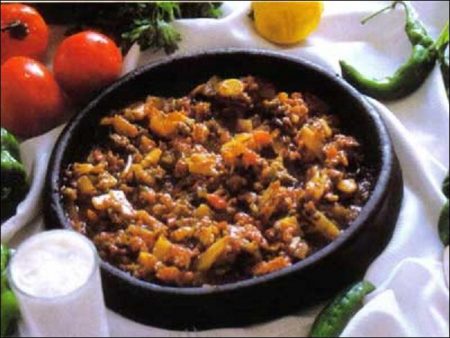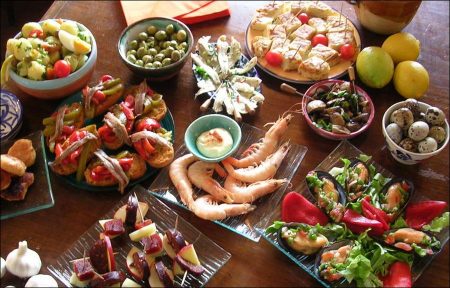Moussaka
Moussaka is an eggplant- (aubergine) or potato-based dish, often including ground meat, in the cuisines of the countries of the former Ottoman Empire, with many local and regional variations.
In Turkey, it is sautéed and served in the style of a casserole, and consumed warm or at room temperature. In Arabic countries, a variant is eaten cold. In the Balkans, the dish is layered and typically served hot. Many versions have a top layer made of milk-based sauce thickened with egg (custard) or flour (béchamel sauce).
The English name for moussaka comes from Greek mousakás, which derived from the Turkish musakka, which itself came from Arabic musaqqa‘ah, meaning “chilled”.
Greek Style Moussaka
Most versions are based primarily on sautéed aubergine (eggplant) and tomato, usually with minced meat. However, the Greek version includes layers of meat and eggplant topped with a Béchamel (“white”) sauce, and baked.
The modern Greek version was probably formulated by chef Tselementes in the 1920s. It has three layers that are separately cooked before being combined for the final baking: a bottom layer of sliced eggplant sautéed in olive oil; a middle layer of ground lamb lightly cooked with chopped or puréed tomatoes, onion, garlic, and spices (cinnamon, allspice and black pepper); and a top layer of Béchamel sauce or savoury custard.
The composed dish is then layered into a pan and baked until the top layer is browned. Moussaka is usually served warm, not piping hot; if cut hot out of the oven, moussaka squares tend to slide apart and consequently the dish needs some resting time to firm up before serving. Reheating, however, does not present the same problem.
There are variations on this basic recipe, sometimes with no top sauce, sometimes with other vegetables. Such variants may include, in addition to the eggplant slices, sautéed zucchini (courgette) slices, part-fried potato slices, or sautéed mushrooms. There is a fast-day (vegan) version in the Greek cookbook by Tselementes, which includes neither meat nor dairy products, just vegetables (ground eggplant is used instead of ground meat), tomato sauce, and bread crumbs.
Another variant is (melitzanes) papoutsakia (lit. ‘eggplant, little shoe style’) which consists of whole small eggplant stuffed with ground meat and topped with béchamel and baked, somewhat similar to the Turkish karnıyarık.
Turkish Style Moussaka
Turkish musakka is not layered.[3] Instead, it is prepared with sautéed eggplant, green peppers, tomatoes, onions, and minced meat. It is generally eaten with pilav and cacık. There are also variants with zucchini (kabak musakka), carrots (havuç musakka) and potatoes (patates musakka).
Tapas
Spanish cuisine is based on seafood, with mediteranean influences. A very frequent dish is Tapas, an appetizer which the locals serve when they get out in town for a drink, the speciality also choosen by me from the Spanish dishes. Tapas is made of fish and seafood (anchovy, mackerel, sardine, octopus) with olive oils or tomato souce, paprika and chilli.
Tapas are a wide variety of appetizers, or snacks, in Spanish cuisine. They may be cold (such as mixed olives and cheese) or hot (such as chopitos, which are battered, fried baby squid). In select bars in Spain, tapas have evolved into an entire, sophisticated cuisine. In Spain, patrons of tapas can order many different tapas and combine them to make a full meal. In some Central American countries, such snacks are known as bocas. In Mexico, the vegetarian varieties of similar dishes are called “botanas”.
The serving of tapas is designed to encourage conversation, because people are not so focused upon eating an entire meal that is set before them.[citation needed] Also, in some countries it is customary for diners to stand and move about while eating tapas.
The word “tapas” is derived from the Spanish verb tapar, “to cover”, cognate to English top. Before the 19th century, European roads were in bad condition. Some were originally old Roman roads (viae romanae), some were trails dating from the Middle Ages. Travelling was slow and exhausting.
Most people could not read or write, and Spain was no exception. Inns, called posadas, albergues or bodegas, grew up along the roads, offering meals and rooms, plus fresh horses for travellers. Since few innkeepers could write and few travellers read, inns offered their guests a sample of the dishes available, on a “tapa” (the word for pot cover in Spanish). In fact, a “tapa” was (and still is) a small portion of any kind of Spanish cuisine.
According to The Joy of Cooking, the original tapas were the slices of bread or meat which sherry drinkers in Andalusian taverns used to cover their glasses between sips. This was a practical measure meant to prevent fruit flies from hovering over the sweet sherry (see below for more explanations). The meat used to cover the sherry was normally ham or chorizo, which are both very salty and activate thirst. Because of this, bartenders and restaurant owners created a variety of snacks to serve with sherry, thus increasing their alcohol sales. The tapas eventually became as important as the sherry.
Tapas have evolved through Spanish history by incorporating new ingredients and influences. Most of the Iberian Peninsula was invaded by the Romans, who introduced the olive and irrigation methods. The discovery of the New World brought the introduction of tomatoes, sweet and chili peppers, maize (corn) and potatoes. These were readily accepted and easily grown in Spain’s microclimates.
There are many tapas competitions throughout Spain. There is only one National Tapas competition, which is celebrated every year in November. Since 2008, the City of Valladolid and the International School of Culinary Arts have celebrated the International Tapas Competition for Culinary Schools. Various schools from around the world come to Spain annually to compete for the best tapa concept.
Visits: 174




